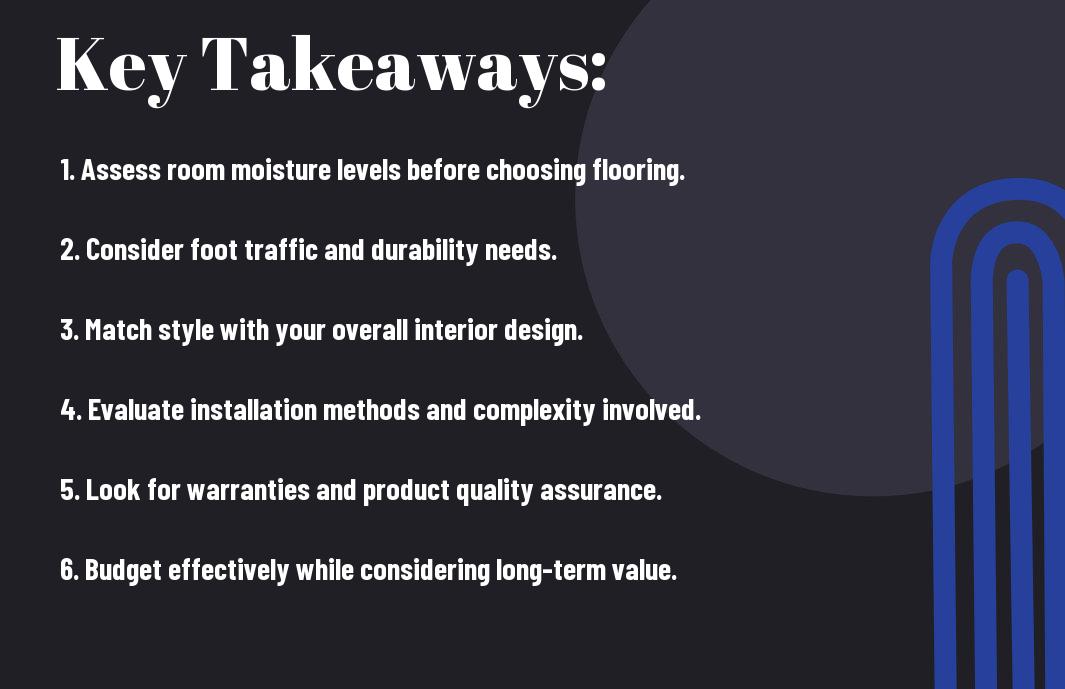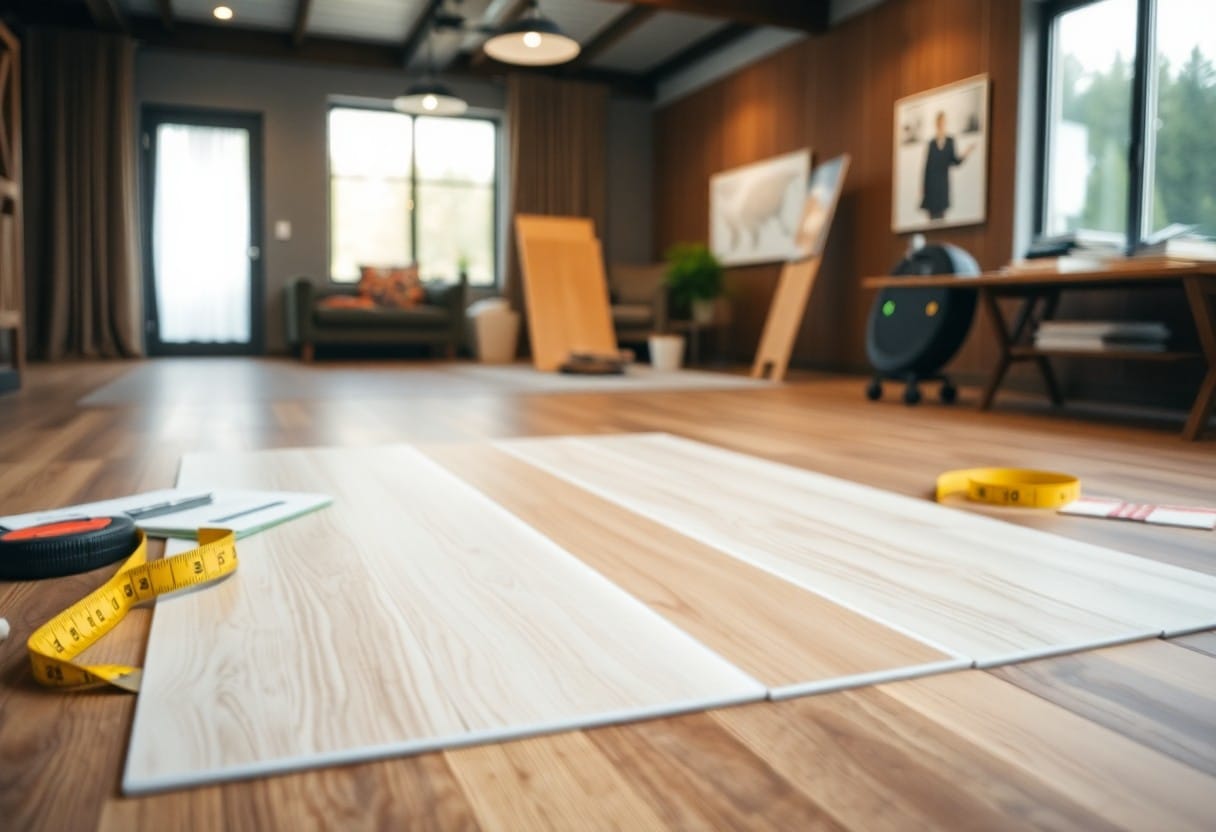There’s a world of options when it comes to choosing the right dry back vinyl flooring for your space. With so many styles, colors, and performance specifications available, making an informed decision is imperative for your home or office. This guide will walk you through the key factors to consider, ensuring you select a product that meets your aesthetic preferences and practical needs. Whether you’re looking for durability, ease of maintenance, or comfort underfoot, understanding these elements will empower you to choose the perfect flooring solution.
Understanding Dry Back Vinyl Flooring
To choose the right flooring option for your space, it’s imperative to understand what dry back vinyl flooring entails. This type of flooring features a sturdy, glue-down installation method that offers a seamless and durable finish. Unlike peel-and-stick or click-lock alternatives, dry back flooring is adhered directly to the subfloor, making it a stable and long-lasting choice for various environments.
What is Dry Back Vinyl Flooring?
The term “dry back vinyl flooring” refers to a specific installation method that involves gluing the vinyl planks directly to the floor. This approach allows for a more secure fit, minimizing movement and providing a more stable and solid feel underfoot. As a result, it’s commonly found in commercial spaces and high-traffic areas, offering aesthetic appeal and functionality.
Benefits of Dry Back Vinyl Flooring
Flooring enthusiasts often appreciate the advantages of dry back vinyl due to its durability, ease of maintenance, and cost-effectiveness. This type of flooring is resistant to moisture, making it ideal for kitchens and bathrooms. It’s also available in a plethora of designs, ensuring you can find the perfect style to match your decor. Furthermore, the glued-down method enhances its stability, providing a reliable surface that withstands daily wear and tear.
Further, dry back vinyl flooring’s sound-dampening capabilities can help create a quieter environment, which is beneficial in both residential and commercial settings. Its easy maintenance means you can spend less time cleaning and more time enjoying your beautifully designed space. With a wide range of styles and finishes available, you’ll find a solution that fits your aesthetic needs without compromising on quality or durability.

Key Factors to Consider
If you’re planning to select the ideal dry back vinyl flooring for your space, there are important factors to think about to ensure you make the best choice:
- Durability and wear layer thickness
- Style and aesthetic options
- Installation and maintenance requirements
- Budget and warranty
Assume that considering these elements will guide you toward a flooring option that meets your needs and enhances your home.
Durability and Wear Layer Thickness
Beside aesthetics, durability is vital when opting for dry back vinyl flooring. The wear layer thickness determines how well your flooring will withstand daily foot traffic, spills, and scratches. A thicker wear layer typically offers better protection, making it suitable for busy households or commercial spaces.
Style and Aesthetic Options
Style is another important aspect to address when choosing your dry back vinyl flooring. This flooring comes in an extensive range of designs, textures, and colors, allowing you to tailor your space according to your personal taste and the existing décor. From wood-like patterns to stone-inspired finishes, there’s a look that fits your vision.
Durability also plays a significant role in your aesthetic choices, as higher-quality options can better mimic natural materials. You can find various shades and prints that evoke the warmth of hardwood or the elegance of marble, ensuring that your flooring improves your interior design while providing lasting support.

Installation Considerations
Now that you’ve selected the perfect dry back vinyl flooring for your space, it’s crucial to understand the installation considerations. This phase is vital for ensuring your flooring performs at its best and lasts for years to come. It’s important to assess your subfloor, choose the right installation method, and prepare adequately to create a sturdy foundation for your new flooring.
Subfloor Requirements
Among the first steps in your installation process is evaluating the subfloor. Your subfloor must be clean, dry, and level to create an ideal surface for your vinyl flooring. Any imperfections can lead to installation difficulties and may affect the overall longevity and performance of your flooring.
Installation Methods
For optimal results, you’ll want to choose an installation method that aligns with your flooring type and space requirements. The common installation techniques for dry back vinyl include glue-down and loose-lay options. Your choice will depend on factors such as your subfloor type, usage area, and personal preferences.
Consequently, understanding the advantages of each method will guide you in making the best decision. Glue-down installations offer a solid bond and are well-suited for high-traffic areas, while loose-lay options provide flexibility and ease of installation. Assess your specific needs, including moisture levels and room usage, to determine which method aligns best with your project requirements.
Maintenance and Care
All vinyl flooring types, including dry back, require regular maintenance to retain their aesthetic appeal and durability. Proper care will help extend the life of your flooring and keep it looking pristine. Regular sweeping or vacuuming to remove dirt and debris, combined with periodic mopping using the appropriate cleaner, will ensure your floors stay in the best condition. Don’t forget to address spills immediately to prevent staining.
Cleaning Tips
Against the odds of wear and tear, you can keep your dry back vinyl flooring looking its best by following these cleaning tips:
- Regularly sweep or vacuum to eliminate dust and grit.
- Use a damp mop and a vinyl-specific cleaner for deeper cleaning.
- Wipe up spills immediately to avoid stains.
- Avoid abrasive cleaners that can damage the surface.
This simple routine will help maintain the look and life of your flooring.
Long-term Care Strategies
After your initial cleaning and care routine, long-term care strategies are crucial for sustaining the beauty and utility of your vinyl flooring. Keeping heavy furniture on felt pads can prevent indentations, and using area rugs in high-traffic areas can significantly reduce wear and tear. Additionally, ensure that you avoid harsh chemicals during cleaning, as they can impact the finish and integrity of the floors.
Further, consider incorporating humidity control in your home to protect your vinyl flooring from warping. Use entrance mats to minimize dirt brought in from outside and maintain a consistent temperature. Regularly inspect your flooring for signs of damage, and act promptly if any issues arise. These steps will help you enjoy your dry back vinyl flooring for years to come.
Cost Analysis
After evaluating your options for dry back vinyl flooring, it is vital to conduct a thorough cost analysis. This will help you understand the various pricing structures, including materials, installation costs, and potential maintenance expenses. Balancing your budget against the quality and longevity of the flooring will ultimately guide you in making a sound financial decision suitable for your home or business.
Budgeting for Your Project
Against the backdrop of your overall renovation or construction budget, it’s vital to allocate a specific amount for your flooring. Consider all factors, including materials, labor, and additional expenses, to set a realistic budget. Understanding your financial boundaries will ensure that you make informed choices without overspending, allowing you to enjoy your new flooring project with peace of mind.
Cost vs. Value Assessment
Beside the initial investment, it is important to consider the long-term value of your flooring choice. Cheaper options may save you money upfront, but they could incur higher maintenance costs or require earlier replacement. Evaluating how your flooring choice aligns with your lifestyle needs and potential resale value will ensure you make a wise investment in the long term.
Cost should always be compared with value when selecting your flooring. Investing in a higher-quality product may seem daunting at first, but the durability, lower maintenance requirements, and aesthetic appeal can provide significant returns in the years to come. By weighing these factors against your budget, you can find a balance that meets your financial constraints while also providing a flooring option that enhances your living or working space.
To wrap up
Conclusively, when selecting the perfect dry back vinyl flooring, you should consider factors such as thickness, durability, style, and ease of installation. Evaluate your space’s specific needs and look for quality materials that will stand the test of time. It’s also important to factor in the maintenance requirements and budget to ensure a wise investment. By taking these elements into account, you can make an informed decision that enhances your home’s aesthetic while providing functionality and comfort.


